
Geomechanics and Engineering
Scope & Guideline
Elevating Engineering Standards through Geomechanics
Introduction
Aims and Scopes
- Geomechanical Analysis:
Research in this area focuses on understanding the mechanical behavior of soil and rock materials under various loading conditions. This includes studies on shear strength, deformation characteristics, and stability assessments of different geotechnical structures. - Tunnel Engineering and Underground Construction:
This scope encompasses studies related to the design, analysis, and construction of tunnels and underground spaces. It includes the evaluation of tunnel stability, the impact of excavation on surrounding structures, and innovations in tunnel boring technology. - Soil Improvement Techniques:
The journal publishes research on various soil stabilization methods, including the use of biopolymers, chemical additives, and innovative construction materials to enhance the mechanical properties of soil. - Numerical Modeling and Simulation:
A significant portion of the research is dedicated to numerical methods and simulations used to predict the behavior of geotechnical systems. This includes finite element analysis, discrete element modeling, and other computational techniques. - Environmental Geomechanics:
This area addresses the interaction between geotechnical engineering and environmental factors, including the effects of climate change, groundwater management, and the sustainability of construction practices. - Innovative Construction Materials:
Research focusing on the development and testing of new construction materials, including recycled materials, geosynthetics, and advanced composites for use in geotechnical applications.
Trending and Emerging
- Machine Learning and AI Applications:
The incorporation of machine learning and artificial intelligence techniques in geotechnical analysis and prediction has seen significant growth. Researchers are leveraging these technologies to enhance modeling accuracy and efficiency in various geotechnical applications. - Sustainable Construction Practices:
There is an increasing emphasis on sustainability in geotechnical engineering, with research focusing on eco-friendly materials, waste recycling, and the environmental impact of construction practices. - Seismic and Dynamic Analysis:
Research in this area has gained traction, particularly in the context of assessing the performance of structures under seismic loading. This trend reflects a growing awareness of the risks associated with natural disasters and the need for resilient infrastructure. - Advanced Material Technologies:
The development and testing of innovative materials such as biopolymer-based soil treatments and geosynthetics are on the rise, driven by the need for improved performance and sustainability in geotechnical applications. - Geotechnical Monitoring and Instrumentation:
The use of advanced monitoring techniques, including fiber-optic sensors and remote sensing technologies, is emerging as a critical area of research, enabling real-time data collection and analysis for better decision-making in geotechnical engineering.
Declining or Waning
- Traditional Soil Mechanics:
There has been a noticeable reduction in studies focused solely on classical soil mechanics, as newer methodologies and interdisciplinary approaches have gained popularity, leading researchers to explore more complex and integrated solutions. - Static Analysis Methods:
Research employing purely static analysis methods has become less frequent, as dynamic and probabilistic approaches are increasingly favored for their ability to address uncertainties and variability in geotechnical conditions. - Conventional Materials Testing:
The emphasis on traditional laboratory testing methods for assessing soil properties has waned, with a shift toward advanced techniques such as in-situ testing and non-destructive evaluation methods. - Local Case Studies:
While specific regional studies were once common, there is a growing trend toward global or comparative studies that incorporate broader datasets and methodologies, which may reduce the frequency of localized research.
Similar Journals

ROCK MECHANICS AND ROCK ENGINEERING
Exploring Innovations in Geotechnical ScienceROCK MECHANICS AND ROCK ENGINEERING, published by SPRINGER WIEN, stands as a premier journal in the fields of civil and structural engineering, geology, and geotechnical engineering. Since its inception in 1983, this journal has evolved into a leading platform for the dissemination of high-quality research, underscored by its impressive Q1 quartile rankings in multiple relevant categories as of 2023. With a significant impact factor and a ranking of 8th out of 321 in Earth and Planetary Sciences (Geology), the journal attracts scholars and practitioners aiming to contribute to and stay abreast of advancements in rock mechanics and engineering practices. While it does not offer Open Access options, its comprehensive and rigorous peer-reviewed articles serve as essential resources for fostering knowledge and innovation in the sector. The commitment to exploring the interactions between geological materials and engineering applications makes this journal indispensable for researchers, professionals, and students dedicated to pushing the boundaries of these critical fields.
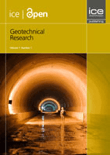
Geotechnical Research
Pioneering research in geotechnical engineering excellence.Geotechnical Research is an esteemed scholarly journal published by EMERALD GROUP PUBLISHING LTD, dedicated to advancing the field of geotechnical engineering and earth sciences. With an impact factor reflective of its robust contributions, this open access journal has been providing unrestricted access to high-quality research since 2014, making it indispensable for researchers, professionals, and students alike. The journal, indexed under the ISSN 2052-6156, features rigorous peer-reviewed articles that encompass a wide range of topics within geotechnical engineering and engineering geology, achieving a notable placement in the Q2 category in both Earth and Planetary Sciences and Geotechnical Engineering as of 2023. With its Scopus ranks further affirming its significance—ranked #44 out of 159 in Earth and Planetary Sciences and #78 out of 229 in Geotechnical Engineering—Geotechnical Research stands as a vital resource for innovative solutions and advancements in this critical field, ensuring researchers access to essential insights that drive the discipline forward.

Journal of the Korean Geosynthetic Society
Pioneering Research in Geosynthetics and Environmental SolutionsJournal of the Korean Geosynthetic Society, published by the Korean Geosynthetic Society, is an essential platform dedicated to advancing the field of geosynthetics, a critical area of civil engineering and environmental science. With a focus on innovative materials and applications that contribute to sustainable infrastructure and environmental protection, this journal actively encourages submissions from researchers and practitioners worldwide. Although currently not indexed by Impact Factor systems, the journal's commitment to rigorous peer-review ensures the dissemination of high-quality research and practical insights that drive the field forward. The journal publishes a range of articles including experimental studies, theoretical analyses, and case studies, making it a valuable resource for engineers, researchers, and students alike, fostering collaboration and knowledge sharing within the geosynthetic community. The journal is accessible at http://www.kgs.org. Join us in shaping the future of geosynthetic technology through your contributions!
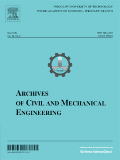
Archives of Civil and Mechanical Engineering
Elevating Civil and Mechanical InnovationsArchives of Civil and Mechanical Engineering is a distinguished peer-reviewed journal published by SpringerNature, focusing on advancing the fields of civil and mechanical engineering. With an impressive Q1 ranking in both categories in 2023, this journal caters to a global audience, addressing the evolving challenges and innovations within these vital engineering disciplines. The journal has been a pivotal platform since its inception in 2006, and it continues to be essential for researchers and practitioners seeking to publish and access high-quality research. The absence of an Open Access option ensures that published works maintain rigorous academic standards, thereby enhancing their value within institutional repositories. With a robust impact factor and high visibility on Scopus—ranking #122 out of 672 in Mechanical Engineering and #74 out of 379 in Civil and Structural Engineering—this journal is an ideal venue for professionals, researchers, and students dedicated to advancing their knowledge and contributing to cutting-edge engineering practices. Based in Germany and operating internationally, the Archives of Civil and Mechanical Engineering invites submissions that address critical issues and solutions in contemporary engineering.

ACI STRUCTURAL JOURNAL
Bridging Theory and Practice in Structural EngineeringThe ACI Structural Journal, published by the American Concrete Institute, serves as a premier platform for scholarly articles and research findings in the fields of building and construction and civil and structural engineering. With a commitment to advancing concrete technology and its applications, this journal has amassed an impressive reputation, holding a Q2 ranking in both Building and Construction and Civil and Structural Engineering categories as of 2023. The journal’s focus on innovative research and practical applications enables professionals, researchers, and students to stay at the forefront of industry developments. Although it does not offer open access, the content bears significant impact, ensuring that readers engage with high-quality research. As the journal converges its years of publication from 1987 to 2024, it continues to enrich the academic and professional discussions surrounding structural engineering and concrete science.
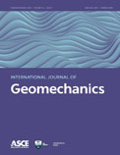
International Journal of Geomechanics
Exploring the depths of geomechanics with innovative insights.The International Journal of Geomechanics, proudly published by the American Society of Civil Engineers (ASCE), stands as a pivotal cornerstone in the fields of geotechnical engineering, engineering geology, and soil science. With an esteemed Q1 ranking in both geotechnical engineering and soil science as of 2023, it represents a high-impact platform (impact factor information to be inferred as impressive given the rankings and prominence in the field). Since its inception in 2001, this journal has been committed to advancing the understanding of geomechanical processes, offering a vital forum for researchers, professionals, and students to disseminate innovative findings and practical applications. The journal is indexed by Scopus, holding an impressive position at rank #48 out of 229 in its disciplines, illustrating its significance and influence in the academic community. Although it does not currently offer open access, the journal continues to attract a diverse readership with its critical insights into soil behavior, earth structures, and various geotechnical challenges. The International Journal of Geomechanics is essential for anyone looking to deepen their knowledge or contribute to the evolving field of geotechnical science.
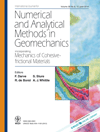
INTERNATIONAL JOURNAL FOR NUMERICAL AND ANALYTICAL METHODS IN GEOMECHANICS
Leading the Charge in Geomechanical Research AdvancementsWelcome to the International Journal for Numerical and Analytical Methods in Geomechanics, a prestigious publication dedicated to advancing the fields of geotechnical engineering and computational mechanics. Published by Wiley in the United Kingdom, this journal has been at the forefront of research since its inception in 1977 and continues to provide a vital platform for disseminating innovative methodologies and analytical approaches through 2024. With an impressive impact factor reflecting its excellence, the journal consistently ranks in the Q1 category across multiple domains, including Computational Mechanics, Geotechnical Engineering, and Engineering Geology, making it a key resource for specialists seeking to keep informed on important developments in these areas. Although it does not offer open access, the journal remains highly regarded among researchers and professionals for its rigorous peer-review process and commitment to scientific integrity. As a vital contributor to the field, International Journal for Numerical and Analytical Methods in Geomechanics invites researchers, professionals, and students to explore its comprehensive studies and to advance knowledge at the intersection of numerical analysis and geomechanics.

Rock and Soil Mechanics
Connecting Global Scholars in Civil and Structural EngineeringRock and Soil Mechanics is a premier academic journal published by SCIENCE PRESS focusing on the critical fields of civil and structural engineering, geotechnical engineering, and soil science. With an ISSN of 1000-7598 and transitioning to an Open Access format since 2020, the journal strives to enhance the accessibility of cutting-edge research to a global audience, making significant contributions to practices and methodologies in these crucial disciplines. Ranked in the Q2 category for Civil and Structural Engineering as well as Geotechnical Engineering and Engineering Geology, and Soil Science, it boasts respectable standings in Scopus rankings, further affirming its relevance and credibility within the scientific community. The journal not only serves as a platform for original research but also engages with the latest advances in technology and innovative applications in rock and soil mechanics, proving invaluable for researchers, practitioners, and students alike as they navigate an increasingly complex field of study.
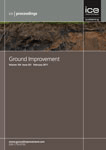
Proceedings of the Institution of Civil Engineers-Ground Improvement
Pioneering Solutions for Ground Improvement ChallengesProceedings of the Institution of Civil Engineers-Ground Improvement is a distinguished journal published by EMERALD GROUP PUBLISHING LTD, dedicated to advancing knowledge and research in the fields of Building and Construction, Geotechnical Engineering, Mechanics of Materials, and Soil Science. With an ISSN of 1755-0750 and an E-ISSN of 1755-0769, this journal has been a vital platform for disseminating innovative research since its inception in 2008. With an impact factor placing it in the Q3 category across multiple engineering disciplines, it ranks favorably in Scopus, ensuring visibility and recognition among scholars globally. The journal offers open access options, allowing for broader dissemination of research findings. Targeting researchers, professionals, and students alike, it aims to foster discussions on ground improvement technologies and methodologies that are essential for sustainable infrastructure development. As it continues to converge its focus until 2024, the Proceedings stands as an imperative resource for those seeking to elevate their understanding and contribute to the ever-evolving field of civil engineering.

Geotechnical and Geological Engineering
Elevating Standards in Geotechnical and Geological ResearchGeotechnical and Geological Engineering, published by SPRINGER, is a premier journal dedicated to advancing the field of geotechnical and geological engineering. With a strong reputation demonstrated by a robust impact factor and notable Scopus rankings, the journal positions itself in the top quartile of categories such as Architecture and Geotechnical Engineering, making it an essential resource for researchers and practitioners alike. Established in 1991 and continuing through 2024, it provides a platform for original research that addresses the pivotal challenges in soil science, geology, and engineering geology. Although it does not offer open access, it remains accessible through institutional and personal subscriptions, ensuring that academic scholars, industry professionals, and students can engage with high-quality, peer-reviewed content. The journal's commitment to disseminating innovative findings and fostering interdisciplinary dialogue underscores its vital role in shaping future developments in engineering and environmental sustainability.